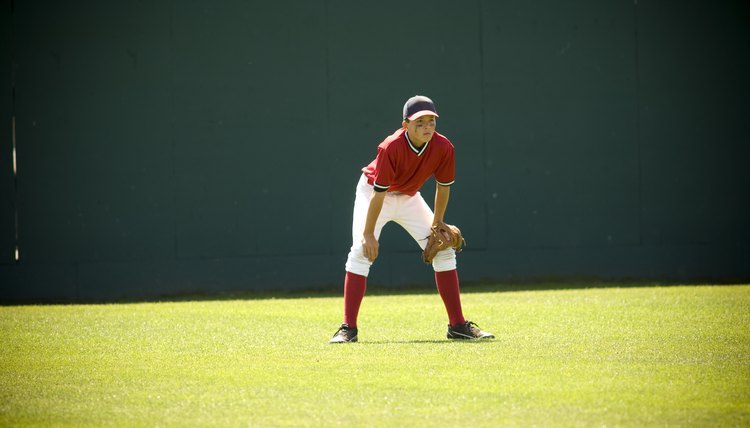Baseball Positions and Abbreviations, like bb Baseball Mening

When watching a Major League Baseball game, a beginner might be confused by the many abbreviations like HR for home run, BB for base on balls, or the ever confusing K for strikeout. These confusions may include the letters next to a player's name. Letters like P, 1B, LF, C, are commonplace in baseball but it might be daunting for a beginner to know what they mean. In order to understand where people play and expertly understand statistics, you must first know what the baseball position abbreviations are and what they mean. Here are the baseball position abbreviations as they are used in scorekeeping.
What are the infield abbreviations?

Comstock Images/Stockbyte/Getty Images
In baseball, the infield is the four positions played near the bases. They are the first line of defense for any batted ball and play an important role on most plays. The defensive positions that involve the bases are first base, second base, shortstop and third base. They often field most ground balls and create ground outs.The infield, abbreviated IF, consists of these four positions:
- 1B - The abbreviation for the first baseman, who plays near first, is 1B
- 2B - The abbreviation for second base, who plays near second, is 2B. They often create double plays with either the SS or 1B
- 3B - The abbreviation for the third baseman, who plays near third is 3B. They often start triple plays
- SS - The abbreviation for shortstop, which lines up between second base and third base, is SS.
The responsibilities of these positions include catching balls that are hit by the hitter and catching balls that are thrown by other fielders. In the MLB, these players are forced to stay on the infield grass during plate appearances due to the new rules of the shift.
What are the pitcher abbreviations?

Comstock Images/Stockbyte/Getty Images
The pitcher is the position that starts every play by throwing the ball to the batter in the strike zone. The abbreviation for the pitcher is simply P. The pitcher's other main responsibility is to field any balls near the center of the baseball diamond. The pitcher position can also be broken down into two abbreviations: SP and RP. They are only allotted three pick off attempts before they must pitch. If they exceed three, it is a balk.
- SP - SP stands for Starting Pitcher or the pitcher that starts the game. The amount of runs they give up in average is calculated via Earned Run Average or ERA. Another important stat os batting average against, this divides the number of base hits by at bats. <br>
- RP - RP stands for Relief Pitcher or the pitcher that replaces the starting pitcher or other relief pitchers. Often they pitch for very few innings at a time due to a lack of stamina or specialized pitching styles. <br>
What is the abbreviation for Catcher

Comstock Images/Stockbyte/Getty Images
The catcher is another defensive position and is also the only one of its kind in the game. The abbreviation for the catcher is simply C. The catcher has to catch, or at the very least block, all pitches from the pitcher or hits and pop-ups from the batter in the vicinity of the catcher's position, which is just behind home plate in foul territory.
The catcher also occasionally can throw out an opposing team's base runner on a stolen base attempt. If they throw a runner out, it is a CS or caught stealing. Catchers also give signals to the pitcher for what kind of pitch to make. They also communicate with umpires, field bunts, corral wild pitches and can signal for things like an intentional walk or hit by pitch.
What are the Outfield Abbreviations?

Comstock Images/Stockbyte/Getty Images
In baseball the outfield, abbreviated OF, consists of three regions. These regions are center field, left field and right field. The responsibility of the outfielders is to catch or chase down any balls that are hit by the batter into the outfield and make a return throw, if necessary, to a base or another infielder. They often field most fly balls and create a lot of put outs from snagging them. They also field most sacrifice flies and are responsible for helping to assist throwing out the runner. Most extra base hits come from balls hit into the outfield making it a very important role. The abbreviations for these positions are:
- RF - RF stands for Right Fielder, the outfielder who plays on the right side of the field. <br>
- CF - CF stands for Center Fielder, the outfielder who plays in the middle of the outfield
- LF - stands for Left Fielder, the outfielder who plays on the left side of the field. <br>
Designated Hitter
The designated hitter is the player that only bats in place of the pitcher. They do not take the field at all unless they switch positions with another player. The important stats for a designated hitter is on-base percentage, or OBP, slugging percentage, or SLG, and runs batted in, or RBIs. The abbreviation for a designated hitter is DH.
Writer Bio
Blaise is a Freshman at the University of Missouri, studying Journalism at the world-renowned J school. He is the host of the Fast Five Podcast with his Childhood friend Sam Sinclair and interns with the Sports AI platform Pine Sports. He is a huge fan of the Kansas City Chiefs and the St Louis. Cardinals and hopes to cover them professionally in his near future.
